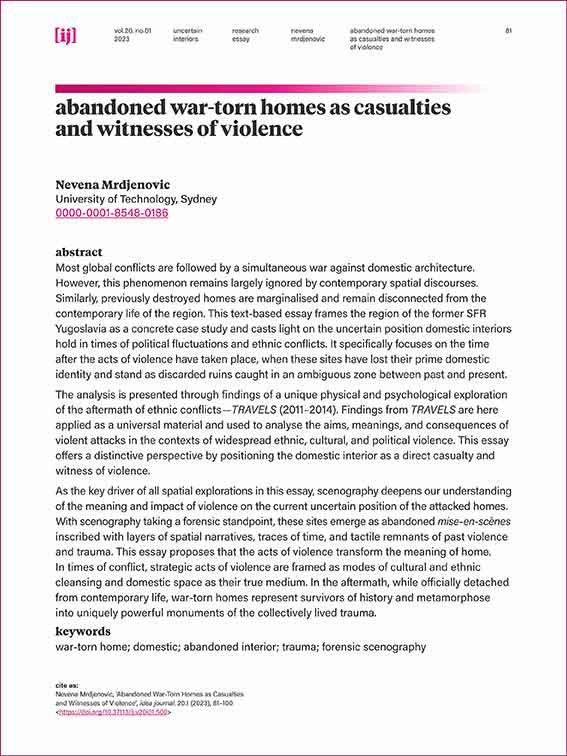Abandoned War-Torn Homes as Casualties and Witnesses of Violence
Main Article Content
Abstract
Most global conflicts are followed by a simultaneous war against domestic architecture. However, this phenomenon remains largely ignored by contemporary spatial discourses. Similarly, previously destroyed homes are marginalised and remain disconnected from the contemporary life of the region. This text-based essay frames the region of the former SFR Yugoslavia as a concrete case study and casts light on the uncertain position domestic interiors hold in times of political fluctuations and ethnic conflicts. It specifically focuses on the time after the acts of violence have taken place, when these sites have lost their prime domestic identity and stand as discarded ruins caught in an ambiguous zone between past and present.
The analysis is presented through findings of a unique physical and psychological exploration of the aftermath of ethnic conflicts — TRAVELS (2011–2014). Findings from TRAVELS are here applied as a universal material and used to analyse the aims, meanings, and consequences of violent attacks in the contexts of widespread ethnic, cultural, and political violence. This essay offers a distinctive perspective by positioning the domestic interior as a direct casualty and witness of violence.
As the key driver of all spatial explorations in this essay, scenography deepens our understanding of the meaning and impact of violence on the current uncertain position of the attacked homes. With scenography taking a forensic standpoint, these sites emerge as abandoned mise-en-scènes inscribed with layers of spatial narratives, traces of time, and tactile remnants of past violence and trauma. This essay proposes that the acts of violence transform the meaning of home. In times of conflict, strategic acts of violence are framed as modes of cultural and ethnic cleansing and domestic space as their true medium. In the aftermath, while officially detached from contemporary life, war-torn homes represent survivors of history and metamorphose into uniquely powerful monuments of the collectively lived trauma.
Article Details
Author/s and or their institutions retain copyright ownership over works submitted to Idea Journal, and provide the Interior Design / Interior Architecture Educators Association with a non–exclusive license to use the work for the purposes listed below:
- Make available/publish electronically on the Idea Journal website
- Publish as part of Idea Journal's online open access publications
- Store in electronic databases, on websites and CDs/DVDs, which comprise of post-publication articles to be used for publishing by the Interior Design / Interior Architecture Educators Association.
Reproduction is prohibited without written permission of the publisher, the author/s or their nominated university. The work submitted for review should not have been published or be in the process of being reviewed by another publisher. Authors should ensure that any images used in their essays have copyright clearance.

